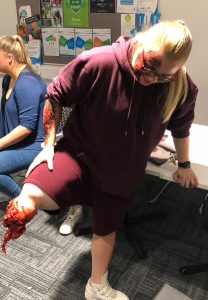The School of Health and Social Care spare no expense in creating realistic simulation for its healthcare students!
The Setting:
On a cold and wet Wednesday afternoon, Blackheath Lane campus became the scene of a traumatic mass-casualty incident. This exercise tested the skills of over 60 healthcare students in managing a simulated terrorist attack where patients had suffered explosive and ballistic injuries.
How Does Simulation Help Students?
Realistic simulation helps a student to consolidate skills in a controlled and realistic environment. Simulation is not designed to be easy, but to replicate the real challenges that our students will face when they qualify as healthcare professionals. The development of competence and resilience are two of the most important outcomes from a student engaging in simulation, allowing promotion of good clinical aptitude and strong mental well-being.
Your experience here at Staffordshire University.
Over the duration of your three year course here at the School of Health and Social Care, you will be provided with many opportunities to engage in multi-disciplinary training. This simply means – practicing with students on other healthcare courses. In first year you will most likely be playing the role of the patients, seeing first-hand how care should be delivered to patients from our more experienced second and third years. As you approach qualification you will become more involved with simulation exercises and start to take lead roles, sharing your knowledge and experience with those around you.
Jack Davies – Lecturer – Health and Social Care

Simulated traumatic amputation

